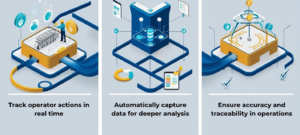Continuous improvement remains a cornerstone of modern manufacturing, driven by the relentless demand for higher efficiency, superior quality, and reduced waste.
As the pressure to do more with less grows, digital transformation has emerged as a game-changing enabler of Lean and Six Sigma methodologies, propelling them to unprecedented levels of effectiveness and scalability.
This next generation of Lean, often called Digital Lean or Lean 2.0, leverages cutting-edge technologies to refine traditional principles of waste reduction and process optimization.
By integrating data-driven insights, IoT, and automation, manufacturers can achieve new benchmarks in operational excellence related to productivity, quality, and sustainability.
What Is Digital Lean or Lean 2.0?
At its core, Digital Lean involves applying advanced data and technology to enhance manufacturing operations.

Lean manufacturing with digital innovation significantly reduces waste and costs.
While the foundational, traditional principles of Lean—streamlining processes, reducing waste, and maximizing efficiency—remain intact, Industry 4.0 digital tools open the door to unprecedented levels of improvement.
This modern approach can enable manufacturers to:
- Detect and address equipment issues in real-time
- Eliminate process inefficiencies
- Reduce defects through data-driven insights
- Achieve measurable sustainability goals
Are outdated processes holding back your path to operational excellence?
Statistically, yes.
Almost all manufacturers (97%) reported challenges around collaboration and employee productivity – with nearly three-quarters (74%) reporting outdated processes as a barrier, according to industry analyst Forrester’s Advanced Manufacturing Report. Furthermore, 98% of manufacturers report at least one issue with data in their organization.
Moving manufacturers beyond outdated processes, Digital Lean replaces manual, paper-based systems with seamless, integrated solutions, ensuring accuracy, consistency, and continuous improvement across all levels of production.
Who Benefits from Digital Lean?
Regardless of size or industry, manufacturers stand to gain significantly from Digital Lean.
Larger manufacturers have long embraced Lean and Six Sigma methodologies, combining them with advanced technology for a competitive edge. Smaller organizations, however, have often relied on manual methods that limit the scope and impact of their improvement programs.
Now, smaller and mid-sized organizations can level the playing field, deploying cost-effective digital tools to amplify the impact of their improvement programs.

Paperless manufacturing improves data collection to supercharge Lean.
What Are the Top Benefits from Digital Lean?
By deploying digital tools, manufacturers can expand the reach of their Lean initiatives. Benefits can include:
- Reduced Downtime: IoT-enabled systems detect and address equipment issues in real time
- Fewer Defects: Data-driven insights help identify and eliminate sources of variation
- Improved Inventory Management: Automated systems optimize stock levels and reduce carrying costs
- Less Waste: Digital tools simplify complex workflows and reduce inefficiencies
- Fewer Operator Errors: Error-proofing and digital instructions enhance accuracy
- Decreased Costs: Digital Lean processes translate directly to cost savings
- Greater Agility: Optimized production lines adapt to fluctuating demand and increasing product variation
Real-World Applications and Results of Lean 2.0
Matrix Automation’s solutions showcase how Digital Lean transforms operations for manufacturers:
- Quality at the Source at Woodbridge: Woodbridge, a leading manufacturer, emphasizes “Quality at the Source” by embedding Lean, ISO, and Six Sigma principles into their processes. Matrix Automation’s solutions have supported their focus on quality and efficiency, enabling them to optimize workflows and maintain compliance. See what Woodbridge says about their Matrix solution.
As Jason Rhodes, Plant Manager at Woodbridge, states: “Matrix’s commitment to our success has made a profound impact, and we see them as an integral part of our business rather than just a service provider.”
- Enhanced Precision and Efficiency: Rhodes further highlights, “ProductionWare has been a game-changer for our team, streamlining our processes and helping us stay ahead in a highly competitive industry.” By leveraging these tools, Woodbridge has achieved increased precision, transparency, and scale without compromising quality.
- Line Balancing: Digital systems facilitate takt time analysis, making it easier to balance and rebalance production lines to meet demand fluctuations.
- Cross-Training: Digitized instructions accelerate cross-training, enabling temporary or new employees to become productive more quickly.
Unlocking Operational Excellence with Digital Lean Unlocks
Matrix Automation exemplifies how digital transformation aligns with Lean and Six Sigma to redefine operational excellence – spanning all steps in DMAIC as well as Lean from Root Cause Analysis and Just-in-Time (JIT) production to Continuous Flow and Takt Time Optimization. Key elements include:
- Data Collection and Measurement: Lean and Six Sigma methodologies emphasize the importance of measurement—“you can’t improve what you don’t measure.” Digital transformation enables seamless data collection across systems, integrating both automated and manual inputs into a cohesive framework. By transitioning to paperless environments, manufacturers can:

- Advanced Analysis Including Root Cause Analysis (RCA): With data collection and measurement automated, manufacturers can analyze vast quantities of historical and real-time data to optimization operations. Furthermore, AI and machine learning (ML) tools empower manufacturers to take analysis to the next level. Proven digital transformation technologies can uncover cause-and-effect relationships and enable faster corrective actions, facilitating identification of bottlenecks, production line balancing and rebalancing, and real-time troubleshooting.
- Collaborative Tools, Visualization, and Digital Kanban: Digital dashboards and automated notification systems enhance collaboration by providing real-time visibility into operations. Features such as Andon systems help operators and supervisors prioritize tasks, escalate issues, and streamline workflows, ensuring faster decision-making, improved communication across teams, and efficient allocation of resources.

Andon systems improve visibility for faster response and collaboration.
- Digital Kaizen: Digital platforms enable teams to brainstorm, share data, and track progress in real-time. Additionally, sensors and IoT devices provide baseline data and post-event metrics to measure improvement impact. Modern manufacturing systems also can suggest optimization opportunities based on historical data and real-time performance trends.
- Standard Work with Digitized Work Processes: By digitizing Standard Operating Procedures (SOPs), manufacturers can move beyond static, paper-based manuals and processes to interactive, step-by-step instructions. Companies can also automatically push updates to instructions when engineering changes are made, reducing downtime. With Electronic Work Instructions systems, manufacturers:
-
- Ensure operators follow standardized processes
- Simplify cross-training and onboarding
- Enable quick adaptations to engineering changes
- Error-Proofing: Digital Lean minimizes human errors by supporting Poka-Yoke (mistake-proofing) methodologies. Systems can automatically detect deviations from specifications, trigger corrective actions in real time, and enforce compliance with internal and external standards.
- Digital Control for Enforced and Tracked Procedures: Continuous improvement programs often experience backsliding when old practices resurface. Digital systems prevent this by tracking operator actions, documenting compliance with procedures, and triggering alerts for out-of-spec conditions and actions. This approach supports the Control phase of DMAIC (Define, Measure, Analyze, Improve, Control), safeguarding gains achieved through Six Sigma projects.
- Value Stream Mapping (VSM): Digital innovation provides dynamic tools to replace static paper-based VSM with real-time digital maps that update dynamically based on data inputs. Simulation allows manufacturers to simulate process changes and predict outcomes before implementation.
The Future of Manufacturing: Operational Excellence Through Digital Lean
Digital technologies and innovation are not just complementary to Lean and Six Sigma—they are transformative.
By integrating advanced tools, manufacturers can unlock a new era of operational excellence. These innovations make Lean principles more accessible, scalable, and impactful, ensuring businesses remain competitive in today’s fast-paced manufacturing landscape. Manufacturers can:
- Uncover deeper insights into operations
- Eliminate inefficiencies and waste at scale
- Build resilience to disruptions in an increasingly dynamic industry
Are you ready to position your business for long-term success in the digital age?
Contact Matrix Automation today to explore how Digital Lean can help you achieve smarter, more efficient manufacturing. Together, we can redefine what’s possible.


